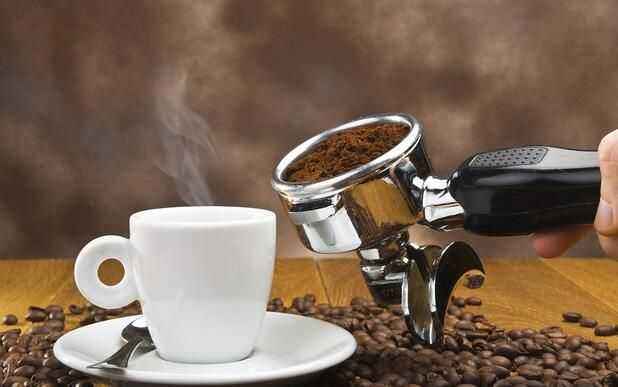Matcha Coffee | what on earth made matcha so popular?!

For professional baristas, please follow the coffee workshop (Wechat official account cafe_style)
Holy Matcha, a matcha-themed cafe, has become a mecca for teenage girls on the west coast of the United States just two months after it opened in San Diego.
Boss Geraldine Ridaura, who came into contact with matcha on a trip to Japan, was immediately impressed by its magical health benefits and became a believer in matcha religion. After returning to the United States, she prepared matcha drinks for herself every day and found that her skin color was brightening day by day, so she made up her mind to share this product with more beautiful girls.
In Holy Matcha, in addition to the signature matcha latte is a must, there are also creative vegetable doughnuts, China pudding, avocado toast and other healthy delicacies, each snack is chic, with the shop's pink decoration, you can't help but take pictures.
The only pity is that the shop that makes dreams come true is located in San Diego, but for friends in Los Angeles, there is another reason for an excursion this weekend.
Not only did the dessert look good, the boss also decorated the whole shop as a paradise for girls-dominated by tender pink, decorated with lots of green plants, plus marble countertops and various brass utensils. It is unreasonable to enter such a dreamy store and take hundreds of selfies without taking out your cell phone.
Holy Matcha
Address: 3118 UNIVERSITY AVENUE SAN DIEGO, CA 92104
Business hours: 10 a. M. To 7 p.m. Daily
INS:@holymatchaa
In Japan, popular drinks have experienced the development process from carbonic acid-coffee-tea drinks. In the 1990s, tea drinks became popular in Japan, and matcha gradually became a mainstream taste in Japanese society. A little-known fact is that matcha, as a typical Asian taste, has already had a profound impact on the taste buds of Westerners. Among them, Americans' preference for matcha continues to rise, consuming nearly half of the exports of Japanese tea, and the word "MATCHA" is widely used.
However, in China, the birthplace of matcha, what once bothered tea sellers was how to make young people fall in love with drinking tea. However, China today and Japan in the 1990s have a lot in common. Both experienced rapid economic growth and then slowed down, while consumer demand for good products is on the rise. With the current upsurge of consumption in China, tea drinks are being sought after by more and more young people.
Starbucks' Teavana has launched two tea drinks in China, and Starbucks CEO Howard Schultz plans to replicate Starbucks's success on Teavana. More local Chinese companies have joined the ranks of tea sellers, including flavored tea, which was invested by Liu Qiangdong with 500 million yuan.
Opportunities for matcha in China. Data from various consumer upgrading communities and platforms show that Chinese consumers' attention to matcha is rising rapidly, and users who used to consume matcha flavors and cheap matcha powder are starting to focus on high-quality matcha. We believe that the growth of matcha demand will promote the upgrading of matcha supply chain in China.
Before you bet on matcha, know what it is.
The correct way to drink ▲ matcha is to order tea. (source network)
Matcha originated in China, rose in the Tang Dynasty and flourished in the Song Dynasty. In the Southern Song Dynasty, the method of ordering tea was introduced into Japan by Zen Master Rongxi. The method of stir-fried green tea which sprang up in the Ming Dynasty could not be introduced into Japan in time due to the implementation of the sea ban, so the Japanese tea ceremony was refined on the basis of Song tea.
Green tea can be divided into original leaf tea and powdered tea. Yuanye tea is the mainstream green tea product in China, while Japan has both. The way to drink matcha is to inject boiling water into a tea bowl filled with matcha powder to stir the tea pot quickly and forcefully to form a fine and uniform foam on the surface of the tea soup. This way of drinking tea is called "ordering tea".
Matcha goes through a series of complex processes from picking to grinding. From the selection of tea trees to shading, picking, steaming, drying, cutting tea, grinding, each of its production links have specific standards.
To make matcha, you should choose tree species with high amino acid and protein content. Matcha is only made from "some tea" picked between March 1 and May 31 each year. In the first 20 days of picking, shade the tea trees to avoid direct sunlight.
In order to retain the chlorophyll in the tea to the maximum extent and make the matcha emerald green, the picked tea should be killed with steam.
The tea after drying and cutting is called "ground tea". It is the raw material for making matcha. It is usually stored in the teacup, and only when it needs to be ground into matcha powder can it be taken out and ground by stone mill.
Stone grinding is a key step in making matcha. The thermal conductivity of stone mill is poor, and the temperature during grinding will not affect the color of matcha too much. After grinding, the particle size of matcha powder is 2-20 microns, that is, 680-6800 mesh. (the number of eyes refers to the number of holes per square inch. The larger the mesh number is, the finer the powder is and the higher the grinding process is. )
After grinding, the substances in tea become smaller particles, in which tea polyphenols, alkaloids, amino acids and other components are more easily dissolved in water, making the nutritional value of matcha to the maximum.
Matcha is not a food additive, but a special powder form of green tea. Compared with simply grinding tea into powder, the production process of matcha is more stringent, complex and has higher nutritional value.
Matcha in China: under the trend of rising consumption, the rise of demand forces supply
In Japan, matcha production has strict quality review and grading standards, and has formed a complete supply chain system. Although China also produces matcha, which used to be mainly manufactured by Japanese companies, most of the green tea powder in the Chinese market is produced and circulated, with a simple process and low value.
The price of low-end matcha powder (green tea powder) on Taobao is 10-20 yuan / 100 grams, while the price of authentic matcha should be 40-60 yuan / 100 grams.
Why is there such a big difference in the matcha industry between China and Japan?
On the supply side, Chinese manufacturers have low requirements for the selection of raw materials, and the production process (especially the key links such as shading, steaming green and stone grinding) is rough.
On the demand side, the mainstream demand faced by Chinese manufacturers is cheap green tea powder and even matcha essence, most consumers can not distinguish between matcha and green tea powder, and price-sensitive.
However, with the upgrading of consumption, consumer demand for matcha will force supply, thus promoting the integration of matcha industry chain:
The education of the new products on the market will deepen consumers' understanding of matcha, which in turn will generate a large demand for high-quality matcha, and matcha flavor and green tea powder will be eliminated.
Thanks to lower land and labor costs and richer raw material resources than Japan, China has an advantage in the supply of production factors.
There is no technical barrier in the production process of matcha.
In industries where the supply chain of ► is not yet mature, such as matcha, the opportunity for startups is to gain the first-mover advantage of integrating the supply chain by building a brand, gathering a single quantity, and then using a single quantity to upgrade the back-end supply chain.
Matcha in Japan: like the coffee chain, it is a mature business.
In Japan, popular drinks have experienced the development process from carbonic acid-coffee-tea drinks.
Carbonated drinks were very popular in the 1970s.
In the 1980s, with the rapid development of Japanese economy and the entry of Western culture, the expansion of vending machines brought convenient sales channels, and coffee beverages became mainstream drinks.
In the 1990s, the tea beverage market grew rapidly. This is due to the maturity of canned and bottled green tea technology, as well as consumers' emphasis on health and light.
After 2000, the overall scale of the Japanese beverage market tends to be stable. In 2005, the tea beverage market reached 931.3 billion yen and accounted for 25.8%, which was comparable to the coffee beverage market (955.1 billion yen, 26.4%). Among them, the size of green tea beverage market is 447 billion yen, accounting for 12.4% of the total [1].
Since then, the coffee market has basically remained stable, while the market scale of tea beverages (including green tea) has declined slightly, accounting for 26% and 24% respectively.
What on earth has matcha experienced to be so popular?!
Matcha has become the mainstream food taste in Japanese society, which began with the rise of tea drinks in the 1990s. Haagen-Dazs launched matcha-flavored ice cream in Japan in 1996 and matcha cappuccino launched by Starbucks in Japan in 2001. The hot sales of these products have promoted the taste of matcha to become mainstream.
Matcha has a variety of mature applications in the market. It can not only be used as a food seasoning, but also can be drunk as a tea drink. Matcha coffee chain is already a mature industry in Japan.
Application 1: food seasoning
Matcha is the only tea food seasoning with slightly astringent taste and suitable for blending sweetness. since the 1990s, matcha has widely appeared in Japanese ice cream, cakes, biscuits and other foods, and occupies a special position in the Japanese market.
Take matcha ice cream as an example. According to the annual survey of "consumers' favorite Ice Cream Taste" released by the Japan Ice Cream Association, matcha taste was still in fifth place in 2010, rising and stabilizing to the third place in 2015, with a preference rate of nearly 50% [2]. On the other hand, the annual consumption of ice cream in Japan has increased steadily. Overall, the Japanese matcha ice cream market has grown steadily in recent years.
▲ Japan Ice Cream Association Annual Survey of consumers' favorite Ice Cream Taste (Source: Japan Ice Cream Association's 2015 Japan Ice Cream White Paper)
▲ Annual Ice Cream consumption in Japan from 2006 to 2015 (data source: Japan Ice Cream Association)
Application 2: matcha beverage
Although the mainstream tea drinks in Japan are oolong tea, green tea, mugi-cha and other original leaf tea, matcha has a large and mature consumer demand in both liquid tea (mainly latte form) and solid tea beverage market.
▲ Itoyuan Group Oi OCha series and matcha new products (first from right) (source network)
In terms of liquid tea, the Oi OCha series of Itoyuan Group, which has the largest market share in Japanese tea beverages, has launched a new type of green tea beverage containing solid matcha precipitation. Coca-Cola of Japan, which has the third market share, also launched a canned latte containing matcha in 2011.
In terms of solid tea, Japan has a mature consumption habit of solid tea drinks, and the market size of portable (Easy-to-use) solid tea drinks is about 25 billion yen. The instant brewing tea with matcha flavor sold in Itoyuan sells more than 10 million copies a year.
Application 3: matcha Coffee chain (Green Tea Cafe)
In Japan, the matcha coffee chain is a mature format. Nana's Green Tea is one of the favorite matcha coffee chains among young people in Tokyo, with 75 stores in Japan.
There are also large tea chains in the United States, of which Teavana is the most popular, with more than 400 stores in the United States. While China's tea chain is still in its infancy, due to flavor tea (inWE) in Shanghai, Beijing, Suzhou and other places have 11 direct stores, Liu Qiangdong 500 million yuan investment.
▲ Teavana Matcha series products
Matcha in the United States: supporting half of Japan's tea exports
Overseas demand for matcha is growing. Hirotaro Tanimoto, vice chairman of the Japan Tea exporters Association, pointed out that the growth of Japanese tea depends on overseas markets. In the United States, which accounts for nearly half of Japan's tea exports, the word "MATCHA" has been widely used, and fruit juices and coffee drinks with matcha elements are becoming more and more common.
Retail sales of matcha powder in the United States increased by 54.9%, and sales of matcha ready-to-drink drinks increased by 253.1%. Although the matcha category currently has a small market base, the North American market is expected to grow at a compound annual growth rate of 25% by 2018.
The ▲ American market has made a great contribution to Japan's matcha exports.
The growth of overseas markets has led to the production of matcha in Japan. According to the national federation of tea production groups, Japanese tea production increased by 10% year on year to 1969 tons in 2014, and is expected to increase by a further 6-7% to about 2100 tons in 2015. The hot sale of ground tea is particularly prominent in the context of the overall low production of tea in Japan.
On the other hand, the expansion of demand for finished products has also pushed up the price of raw materials, making the price of rolled tea at a high level. According to the national agricultural combination federation of japan, the average unit price of fried tea in the Kyoto new tea market fell 7% year-on-year, while the primary tea price of ground tea rose 27% year-on-year to 4720 yen / kg (as of mid-November 2015) [5].
Some references:
[1] Ito En: Japan's green tea market
[2] Japan Ice Cream Association "Japan Ice Cream White Paper 2015"
[3] the Ice Cream Association of Japan has a gold medal for other kinds of products | the Association of Japanese Ice Cream Association
[4] Food Navigator-USA: Matcha green tea market on fire, says report: 'This is not a passing fad, but a major trend'
[5] "Nikkei Chinese website: demand for matcha in Japan"
[6] Ito En Report 2015
How to make matcha coffee
Main ingredients: espresso, matcha powder 15g
Excipients: chilled milk, milk foam
Kitchen utensils: milk foam machine, coffee machine
1. Pour half a cup of milk into a steel milk cup, add the right amount of matcha powder, stir and mix well.
two。 Get rid of the foam. Foam can be used to use steam or a small electric foam blower to get rid of. Use the electric foam machine to get rid of the need to heat the milk to about 65 degrees, at this time the effect is better, the milk foam is also more stable, will not defoaming.
3. Dished matcha milk into the coffee cup, high-quality matcha powder can brush out a rich and delicate foam, pour into the milk foam.
4. Sprinkle with a little tea powder to decorate.
Tips:
1. It is recommended to use better quality matcha powder.
two。 Either chilled milk or light cream is fine.
Important Notice :
前街咖啡 FrontStreet Coffee has moved to new addredd:
FrontStreet Coffee Address: 315,Donghua East Road,GuangZhou
Tel:020 38364473
- Prev

Special topic on Rose Summer | how to make a good cup of Rose Summer
Professional baristas Please follow the Coffee Workshop (Wechat official account cafe_style) [Rose Summer seed] one of the most expensive types of coffee in the world. When it comes to rose summer beans, you have to mention the emerald estate in Panama. In addition to the world-famous summer roses, Jade Manor has repeatedly created amazing transaction records. Daniel is the first coffee to find the unique flavor of rose summer by cup test.
- Next

Thai iced coffee | if you make a cold cup of Thai Gufa iced coffee
For professional baristas, please follow the coffee workshop (Wechat official account cafe_style) very strong coffee mixed with ice cubes, and then add cardamom, a spice native to the East Indies, with cream and sugar, so a cup of Thai iced coffee takes you to Phuket under the scorching sun and sea breeze in an instant. If there is a kind of coffee that can bring you a cool sea on a hot summer day
Related
- Beginners will see the "Coffee pull flower" guide!
- What is the difference between ice blog purified milk and ordinary milk coffee?
- Why is the Philippines the largest producer of crops in Liberia?
- For coffee extraction, should the fine powder be retained?
- How does extracted espresso fill pressed powder? How much strength does it take to press the powder?
- How to make jasmine cold extract coffee? Is the jasmine + latte good?
- Will this little toy really make the coffee taste better? How does Lily Drip affect coffee extraction?
- Will the action of slapping the filter cup also affect coffee extraction?
- What's the difference between powder-to-water ratio and powder-to-liquid ratio?
- What is the Ethiopian local species? What does it have to do with Heirloom native species?

